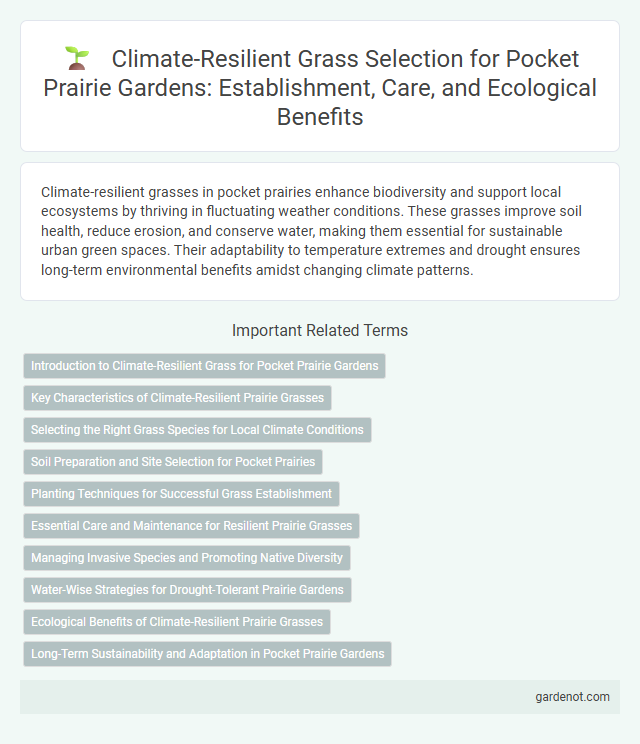Climate-resilient grasses in pocket prairies enhance biodiversity and support local ecosystems by thriving in fluctuating weather conditions. These grasses improve soil health, reduce erosion, and conserve water, making them essential for sustainable urban green spaces. Their adaptability to temperature extremes and drought ensures long-term environmental benefits amidst changing climate patterns.
Introduction to Climate-Resilient Grass for Pocket Prairie Gardens
Climate-resilient grasses in pocket prairie gardens are specifically chosen for their ability to withstand extreme weather conditions such as drought, heat, and heavy rainfall. These grasses improve soil health by enhancing water retention and reducing erosion while providing habitat for beneficial insects and wildlife. Incorporating native species like little bluestem and switchgrass creates a sustainable, low-maintenance garden that supports biodiversity and mitigates climate impacts.
Key Characteristics of Climate-Resilient Prairie Grasses
Climate-resilient prairie grasses exhibit deep root systems that enhance soil stability and water retention during droughts and heavy rainfall. These grasses possess high tolerance to temperature fluctuations and can efficiently photosynthesize under extreme heat. Their adaptability to diverse soil types and resistance to pests make them essential for sustaining ecosystem services in changing climates.
Selecting the Right Grass Species for Local Climate Conditions
Selecting climate-resilient grass species tailored to local temperature, rainfall, and soil type enhances the sustainability of pocket prairies. Native grasses such as Big Bluestem, Switchgrass, and Little Bluestem demonstrate exceptional drought tolerance and adaptability to regional climate variations. Incorporating these species promotes biodiversity, soil stability, and long-term ecosystem resilience in pocket prairie designs.
Soil Preparation and Site Selection for Pocket Prairies
Selecting well-drained, nutrient-rich soil with a pH range of 6.0 to 7.5 optimizes the growth of climate-resilient grasses in pocket prairies. Thorough site preparation involves removing invasive species, tilling the soil to a depth of 4 to 6 inches, and incorporating organic matter to enhance soil structure and moisture retention. Proper site choice prioritizes areas with adequate sunlight exposure and minimal compaction to support root development and long-term ecosystem stability.
Planting Techniques for Successful Grass Establishment
Effective planting techniques for climate-resilient grass in pocket prairies include selecting native, drought-tolerant species adapted to local climates and preparing well-drained, nutrient-rich soil to enhance root establishment. Employing methods such as seed scarification or using seed drills ensures optimal seed-to-soil contact, promoting uniform germination and reducing weed invasion. Timely planting during early spring or late fall leverages natural moisture availability and temperature conditions, increasing survival rates in variable climate scenarios.
Essential Care and Maintenance for Resilient Prairie Grasses
Resilient prairie grasses thrive with minimal watering once established, relying on deep root systems to withstand drought and temperature extremes. Essential care includes periodic mowing or controlled burns to mimic natural cycles and prevent woody plant encroachment, which maintains biodiversity and soil health. Soil aeration and avoiding excessive fertilization support strong root development, enhancing the pocket prairie's climate resilience.
Managing Invasive Species and Promoting Native Diversity
Pocket prairie designs utilize climate-resilient grasses such as Little Bluestem and Big Bluestem to improve ecosystem stability and drought tolerance. Effective management of invasive species like Japanese stiltgrass involves targeted manual removal and the use of selective herbicides to preserve native plant dominance. Promoting native diversity enhances soil health, supports pollinators, and strengthens the prairie's resistance to climate stressors.
Water-Wise Strategies for Drought-Tolerant Prairie Gardens
Climate-resilient grasses such as little bluestem and switchgrass enhance pocket prairie gardens by thriving in low-water conditions and reducing irrigation needs. These drought-tolerant species improve soil health and support native pollinators while conserving water resources. Implementing water-wise strategies like mulching and deep-root watering maximizes the drought resistance of prairie ecosystems.
Ecological Benefits of Climate-Resilient Prairie Grasses
Climate-resilient prairie grasses, such as big bluestem and switchgrass, enhance soil health by preventing erosion and boosting organic matter. These grasses support biodiversity by providing habitat and food sources for pollinators, birds, and beneficial insects. Their deep root systems increase carbon sequestration, mitigating climate change impacts and improving water retention in ecosystems.
Long-Term Sustainability and Adaptation in Pocket Prairie Gardens
Climate-resilient grasses in pocket prairie gardens enhance long-term sustainability by improving soil health and promoting biodiversity. These native species adapt to changing climate conditions through deep root systems that increase water retention and reduce erosion. Incorporating diverse, drought-tolerant grasses supports ecosystem resilience and carbon sequestration in urban green spaces.
Climate-resilient grass Infographic

 gardenot.com
gardenot.com